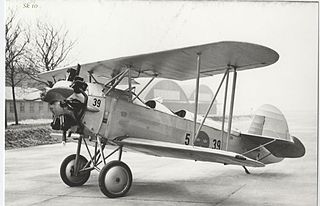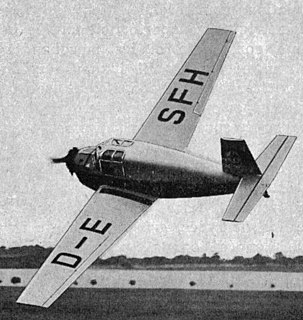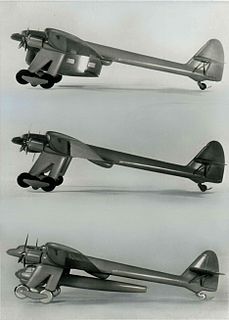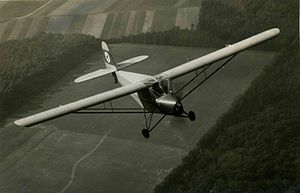
The Fieseler F2 Tiger was a German single-seat aerobatic biplane which was flown to victory in the 1934 World Aerobatics Competition (WAC) by its designer/builder Gerhard Fieseler.

The Fieseler Fi 5 was a single-engined two-seat sportplane of the 1930s. It was produced by the German aircraft manufacturer Fieseler Flugzeugbau, which was started by the World War I fighter ace and German aerobatic star, Gerhard Fieseler.

The Aero A.200 was a sportsplane of Czechoslovakia, designed and built specifically to compete in Challenge 1934, the European touring plane championships. It was a four-seater low-wing monoplane.

The Fieseler Fi 167 was a 1930s German biplane torpedo and reconnaissance bomber designed for use from the Graf Zeppelin class aircraft carriers under construction from 1936 to 1942.

The Fieseler Fi 157 was an unsuccessful attempt at developing a radio-controlled, full-sized anti-aircraft target.

The Fieseler Fi 98 was a prototype ground-attack aircraft produced by German aircraft manufacturer Fieseler as a rival to the Henschel Hs 123.

Raab-Katzenstein RK-26 Tigerschwalbe, also known as the Fieseler F 1 Tigerschwalbe, was a German twin-seat biplane trainer aircraft designed by Gerhard Fieseler by the end of the 1920s.
The Arado Ar 195 was a single-engine prototype carrier-based torpedo bomber, built by the German firm Arado for service on the German aircraft carrier Graf Zeppelin, during World War II.

The Bücker Bü 180 Student was a 1930s German two-seat sporting/training aircraft built by Bücker Flugzeugbau.

The IMAM Ro.63 was an Italian STOL aircraft designed for short-range reconnaissance and light transport during World War II.

The Fieseler Fi 97 was a 1930s German four-seat cabin touring and competition monoplane aircraft designed and built by the German manufacturer Fieseler.
The Klemm Kl 105 was a two-seat sport aircraft developed in Germany in 1938. It was a low-wing cantilever monoplane of conventional design with fixed, tailskid undercarriage, and side-by-side seating for two within an enclosed cockpit. Construction throughout was of wood, with the fuselage built using a new semi-monocoque technique which Klemm patented. Plans to produce the design in series were abandoned with the outbreak of the Second World War.

The Siebel Si 202 Hummel ("Bumble-bee") was a German light sportsplane of the late 1930s. It was an angular low-wing monoplane, which could be powered by a variety of small engines.

The Siebel Si 201 was a German air observation post and army cooperation aircraft, designed and built by Siebel. Evaluated against other types, the Si 201 did not enter production and only two prototypes were built.

The Fieseler Fi 158 was a civilian research aircraft designed and built in Germany from 1938.

The Fieseler Fi 333 was a prototype transport aircraft developed by Fieseler in 1942, and backed by the Luftwaffe.
The Carlson Criquet is an American, two-seats-in-tandem, high wing, strut-braced, single engine, homebuilt aircraft that was designed by Ernst W. Carlson and produced by Carlson Aircraft of East Palestine, Ohio in kit form. The prototype was completed in 1999.

The Fieseler Fi 99 Jungtiger was a German sports aircraft prototype, produced by Fieseler company. The aircraft was a low-wing two-seat aircraft with an enclosed cabin. It was powered by a Hirth HM 506A engine, producing 160 hp (119 kW).

The Gotha Go 150 was a light aircraft designed at the German company Gothaer Waggonfabrik in the late 1930s. It was intended for civilian use, but ended up being used as a military trainer.

The Fieseler F 4 was developed, built and flown as a two-seat sports and travel aircraft at the Fieseler Flugzeugbau.

















